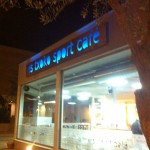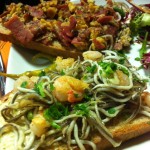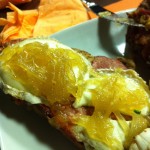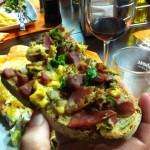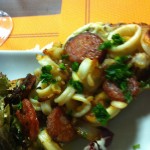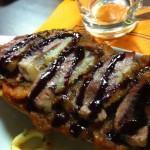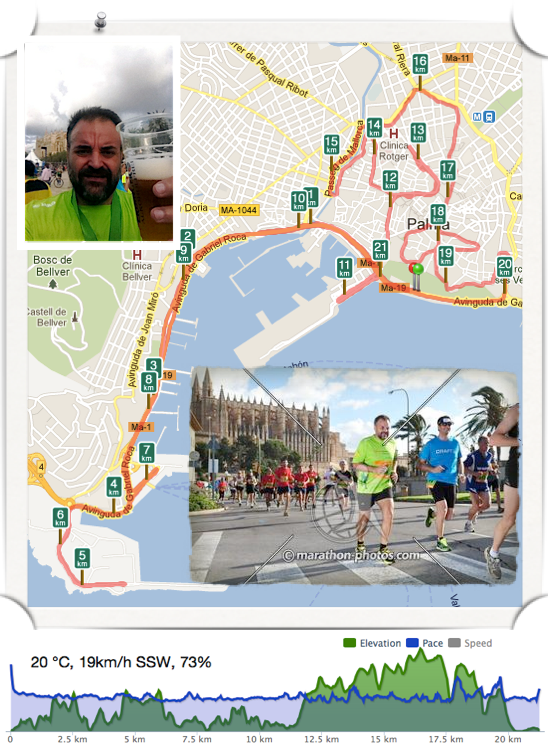Ahir anàrem a sopar al txoko dels germans Coll a Son Ferriol. El lloc és ample i agradable, i està molt ben situat (ben davant l’església i el parc infantil), però el menjar … sense paraules. Jo ja havia tastat el menjar den Sebastià … de fet mitja Mallorca l’ha tastat perquè feia les paelles de l’APiMA del CP Son Ferriol i és una de les poques persones que és capaç de fer una paella per 300 persones i que li surti bona. Els germans Coll han afegit un punt de qualitat al menjar típic de cafè … hamburgueses casolanes i pepitos ben presentats … ensalades variades que no són les que te pots fer a casa … però sobre tot les llesques … o com donar una volta de rosca al pa amb oli de tota la vida. Però bé, una imatge val més que mil paraules …
Blog
Veritats
Cada cosa al seu temps i a l’estiu cigales
Una llagosta sense ales no pot volar
A una casa que no hi ha pa, no estan contents
A una vella sense dents da-li pa moll
Una gerra sense coll no està acabada
A una bota ben buidada ja hi pots munyir
El que s’aixeca dematí pixa allà on vol
Diuen que un llum al sol no fa claror
Un home traïdor fa dues cares
A una bota d’arengades hi ha molts d’ulls
La tercera mitja
10 Km Ciutat de Palma
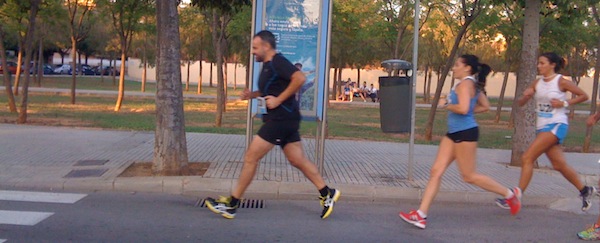
La primera cursa de 10 Km tot un èxit. Temps oficial 50’12”. El recorregut, avorridot. Això de fer 3 voltes allà mateix, cansa. Sobre tot si has de pujar i baixar el pont de Son Gotleu 6 vegades. Però l’ambient, fantàstic. Això sí que és INTEGRACIÓ. Enhorabona als organitzadors (tot i que a la propera hauríem de mirar de partir d’hora i no amb 30 minuts de retard).

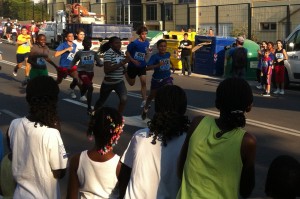
10K x Punta Umbría
Crec que avui he fet els 10K per la platja que tots els corredors d’espardanyeta com jo voldrien tenir a Mallorca. Vegeu el panorama
Es tracta de Punta Umbría. Calcul que més de 20K d’una platja amb més de 10 metres d’arena dura. Perfecte per córrer el dematí mentre acaba de sortir el sol (a Mallorca a les 8 ja pica)
Divendres negre a la UIB contra les retallades
Prou de retallades!
28 mesos després
Quan l’iPad ja va per la 3 versió, 28 mesos després de que Apple revolucionàs el món de les tabletes, Microsoft treu el Surface (bé treure encara no perquè a la web posa “coming soon”). El Surface més o manco fa tot el que feia l’iPad fa 28 mesos més una cosa que no fa l’iPad: com es pot veure a la presentació, el Surface, com totes les coses de Microsoft, també es pot penjar 🙂
Self-focused cognitive emotion regulation style as associated with widespread diminished EEG fractal dimension.
The cognitive regulation of emotions is important for human adaptation. Self-focused emotion regulation (ER) strategies have been linked to the development and persistence of anxiety and depression. A vast array of research has provided valuable knowledge about the neural correlates of the use of specific self-focused ER strategies; however, the resting neural correlates of cognitive ER styles, which reflect an individual’s disposition to engage in different forms of ER in order to manage distress, are largely unknown. In this study, associations between theoretically negative ER style (self-focused or not) and the complexity (fractal dimension, FD) of the resting EEG at frontal, central, parietal, and occipital regions were investigated in 58 healthy volunteers. The Cognitive Emotion Regulation Questionnaire was used as the self-report measure of ER style. Results showed that a diminished FD over the scalp significantly correlated with self-focused ER style scores, even after controlling for negative affect, which has been also considered to influence the use of ER strategies. The lower the EEG FD, the higher were the self-focused ER style scores. Correlational analyses of specific self-focused ER strategies showed that self-blaming and rumination were negatively associated with diminished FD of the EEG, but catastrophizing and blaming others were not. No significant correlations were found for ER strategies more focused on situation or others. Results are discussed within the self-organized criticality theory of brain dynamics: The diminished FD of the EEG may reflect a disposition to engage in self-focused ER strategies as people prone to ruminate and self-blame show a less complex resting EEG activity, which may make it more difficult for them to exit their negative emotional state. Funding for the study was provided by the Spanish Government through grants PSI2009-12711 and SEJ-2006-14301/PSIC. The authors would like to thank Joan Miquel Gelabert, Alfonso Morillas, and Blanca Aguayo, who assisted with physiological recording. We wish to acknowledge the help of Dr Miquel Noguera in programming the FD calculation algorithms.
Heart rate variability profiles and exposure therapy treatment outcome in flight phobia.
The goal of this study was to explore why certain patients in a previous study on exposure therapy for flight phobia did not experience an improvement in their conditions. Participants from a treatment study (N = 45) were selected according to post-treatment results and divided into two groups: the unsatisfactory treatment outcome group (UTO, N = 10) and the satisfactory treatment outcome group (STO, N = 10). The differences between these two groups prior to receiving exposure therapy were analyzed at the behavioral, physiological, and cognitive levels. The UTO participants had been avoiding flying longer than the STO phobics. Following Thayer and Lane’s neurovisceral model of emotion regulation, heart rate variability was analyzed at two levels: tonic and phasic. Low frequency and high frequency (HF) power were calculated in the frequency domain and Sample Entropy was computed in the time domain. The tonic HF power of the UTO group was higher than the STO group’s tonic HF power. In the phasic level, while the STO group’s HF power decreased under exposure and subsequently returned to baseline level, the UTO group demonstrated a more rigid pattern. Finally, the STO group reported higher emotional involvement than the UTO group when they were shown a sample of the therapy. Based on these results, the challenge of matching exposure therapy to each patient’s profile is discussed.
